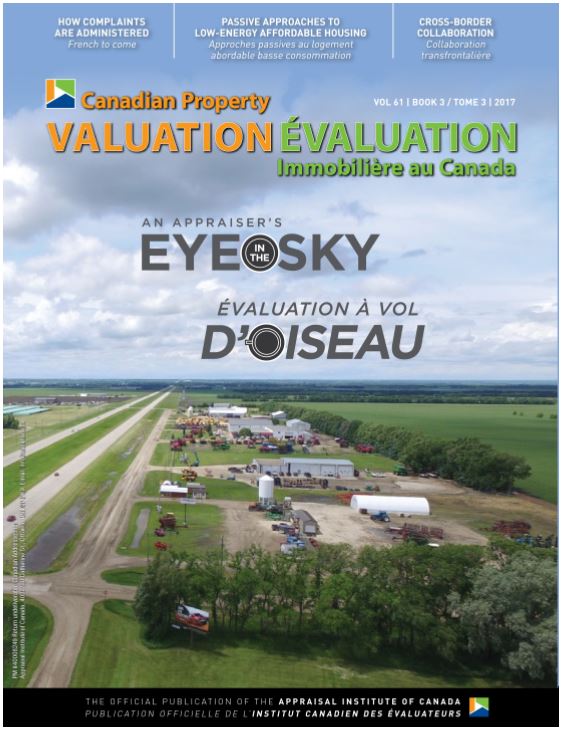Legal Matters: Valuation of Reserve Lands Revisited
Canadian Property Valuation Magazine
Search the Library Online
LEGAL MATTERS
Valuation of Reserve Lands Revisited: Hodgson v. Musqueam Indian Band
Introduction
On May 18, 2017, the Federal Court of Canada – Trial Division rendered its decision in Hodgson v. Musqueam Indian Band, 2017 FC 509 [Hodgson]. It is the latest judicial consideration of the valuation of reserve lands for rental purposes and, as one would expect, Hodgson relies upon the Supreme Court of Canada decision in Musqueam Indian Band v. Glass, 2000 SCC 52 [Glass].
In Hodgson, the broad issue before the court was the determination of annual ‘fair rent’ to be paid by the tenants of 69 residential lots in Musqueam Park, located on Musqueam Indian Reserve No. 2 in southwest Vancouver. The rent review was for a 20-year term commencing June 8, 2015. Annual ‘fair rent’ is described in the applicable leases as 6% of the ‘current land value’ immediately before June 8, 2015.
To say that the competing opinions of ‘fair rent’ diverged would be an understatement. The tenants’ appraiser concluded an average annual rent per lot of $21,151 while the landlord’s appraiser ranged from $115,804 to $226,616. Compare these conclusions to the result in Glass, where the per lot annual ‘fair rent’ was set at $10,000 for the period June 8, 1995 to June 7, 2015.
Several issues were before the court in Hodgson, but space constraints dictate that this article considers only the issue of whether the value of the Musqueam Park lots require adjustment for being on a reserve.
Background
In 1960, a portion of the Musqueam reserve was surrendered by Musqueam Indian Band (MIB) in trust to the federal Crown for the purpose of leasing. The Crown entered into a Master Agreement whereby a development company serviced the lands and subdivided the property into lots. The federal Crown then granted leases for the lots to the development company who, in turn, assigned the leases to other parties. The leases had a 99-year term running from 1965 and provided for periodic rent reviews. The first rent review was in 1995. The object of the rent review was to set ‘fair rent’ based on 6% of the ‘current land value’ as if, among other things, the land was unimproved.
When the parties could not agree on the current market value or the fair rent, litigation made its way ultimately to the Supreme Court of Canada in Glass. In a bare majority of the Supreme Court of Canada justices hearing the appeal, the decision of the Federal Court of Canada – Trial Division was restored and annual fair rent was deemed to be $10,000 per annum – up from the $300 to $400 per annum before the litigation.
The result in Glass was far from unanimous. Five of the nine justices agreed to restore the Federal Court decision, but only four of those five agreed on the basis for restoring the decision. The fifth judge agreed with the result, but for different reasons. Four other justices would have upheld the Federal Court of Appeal decision overturning the Trial Division decision. The result is that no majority of the Supreme Court of Canada agreed on the reasons for restoring the Trial Division decision.
However, it is the reasoning of the four concurring judges to restore the Trial Division decision, written by Mr. Justice Gonthier, that is relied upon in Hodgson, so it is that reasoning that must be reviewed now.
Gonthier J. identified the issues in Glass as the meaning of ‘current land value’ and the interpretation of ‘unimproved lands.’[i] In this article, we deal only with ‘current land value.’
Gonthier J. wrote that ‘current land value’ in the MIB leases meant the fee simple interest, not the leasehold interest. Further, it is the freehold on the reserve, not off the reserve. He acknowledged that this entailed a hypothetical valuation because there never will be freehold land on a reserve. Nonetheless, he and his concurring colleagues were of the view that the hypothetical value could be determined.[ii] As to what the valuation entailed, the learned justice wrote:
46 … This value must reflect the legal restrictions on the land and market conditions. One cannot simply assume that either legal restrictions or market conditions are the same for reserve land as for off-reserve land. In fact, the legal restrictions on the reserve land differ from those on the comparable areas of Vancouver. So too the market may respond differently to Musqueam reserve land than it does to land off the reserve. To give effect to the leases, the land value in the rent review clause must pertain to the actual land in question.
Gonthier J. and his concurring colleagues held that the “fee simple off-reserve value cannot simply be transposed to the Musqueam land …”[iii]
On the evidence appearing in the record, Gonthier J. and his concurring colleagues accepted that a 50% discount between off-reserve lands and reserve lands was appropriate but added “… it will be a question of fact what, if any, discount should be applied.”[iv]
Bastarche J. concurring in the majority result, but not the reasons, would have found that ‘current lease value’ referred to the leasehold interest, which, on the evidence, would not have created a value different from the freehold value given the term left in the lease.
The minority of four justices led by Chief Justice McLachlin were of the view that ‘current land value’ means the actual value of similar land held in fee simple and is not to be reduced by 50% because the land is on a reserve. With respect, it is submitted that the reasons for the Chief Justice’s dissent are strong and, in future cases, we may yet hear arguments based upon the approach the Chief Justice presented.[v]
In any event, the Federal Court in Hodgson adopted the reasoning of the four justices led by Gonthier J. Indeed, it appears to have been the base upon which the parties presented the case.
The valuation challenge
Given the direction from Gonthier J. in Glass, the appraisers in Hodgson had to decide on approaches to account for legal restrictions on land use and market conditions for hypothetical fee simple property on reserve land.
The landlord’s appraiser testified that the challenge could be met by relying upon sales of vacant land in the nearby neighbourhoods of the west side of Vancouver. While acknowledging that it was necessary to consider if adjustments were needed for the off-reserve status of the vacant land sales, the appraiser concluded that there was sufficient similarity between properties on the west side of Vancouver and the lots in Musqueam Park to eliminate any need to adjust. The Federal Court in Hodgson did not so much reject the direct comparison approach, but rather concluded that the evidence in support of the approach was not a reliable enough base upon which to fix the value of the lots. This left the approach presented by the tenants’ appraiser.
The tenants’ appraiser relied upon sales of leasehold interests in the Salish Park subdivision that was also part of the Musqueam reserve lands. He did so because, in his view, the variance in on-reserve and off-reserve values could not easily be determined and would vary from one location to the other. In the absence of clear market evidence of appropriate market-based adjustments, use of sales of west side Vancouver properties was not helpful. The Federal Court accepted that, by using sales of Salish Park leaseholds, an on-reserve discount was not required. However, it did mean the value of the improvements in each Salish Park sale had to be deducted from the sale price. It also meant that an adjustment was necessary to account for the difference in value between leasehold interests and fee simple interests.
The cost of improvements was determined by reference to Marshall Swift tested through discussions with west side builders. Physical depreciation was estimated on the basis of a 60 to 70-year time span. Some functional obsolescence was allowed depending on the age and style of the improvements. Reference to MLS sales photos and a market analysis of sales in North Vancouver were the last inputs. The conclusion was that the average rate of depreciation should be 45%.
As for the leasehold to fee simple adjustment, both appraisers agreed that, if the Salish Park properties still had 99 years left in their terms, the prices on sale would reflect fee simple on-reserve land “almost perfectly,” but since only 58 years remained on the Salish Park leases, an adjustment was required.[vi] The tenants’ appraiser used paired sales of physically similar properties comparing the prices of fee simple sales to leasehold sales having 43 years remaining and calculated a factor of 1.11. He also looked at three other sets of paired data, arriving at a factor of 1.10. To this, he adjusted 5% for a reversionary interest in the leasehold and this drove an overall multiplier of 1.15.
While one might argue that the various steps adopted by the tenants’ appraiser were fraught with ‘appraisal judgment,’ it appears that the court was impressed enough with the thoroughness of the analysis and the lack of sustained challenge on cross-examination that the approach was adopted by the court.
Closing
The Federal Court decision in Hodgson is lengthy; the court was thorough in its discussion of the work of both appraisers. A brief article such as this cannot fully describe the nuances of the case.
Nevertheless, based upon the reasoning of Gonthier J. and his concurring colleagues in Glass and now the Federal Court decision in Hodgson, it appears that determination of ‘current land value’ for on-reserve land will necessarily involve the appraiser in assessing the legal restrictions and market conditions that may impact the fee simple interest in such lands, but that to do so might be a derivative exercise requiring some creativity in approach to find appropriate proxies for value when there is little or no likelihood that reserve land will ever be available in a freehold state.
That said, the strong dissent in Glass suggests that we may not have heard the last of competing arguments for how on-reserve lands are to be valued.
A caveat is in order. The valuation exercise in a rent review is always dictated by the terms of the particular lease in issue. The rent review clauses must be read in the context of the entire lease document to discern the factors that are to be considered in arriving at the required value estimate. There may be, for example, a direction in a lease to value on-reserve lands under the assumption they are off the reserve.
End notes
[i] Glass, para. 24.
[ii] Ibid., para. 35.
[iii] Ibid., para. 49.
[iv] Ibid., paras. 52-53.
[v] Ibid., paras. 12-20.
[vi] Hodgson, para. 90
This article is provided for the purposes of generating discussion and to make practitioners aware of certain challenges presented in the law and in appraisal practice. It is not to be taken as legal advice. Any questions relating to the applicability of cases referred to in the article in particular circumstances should be put to qualified legal and appraisal practitioners.





